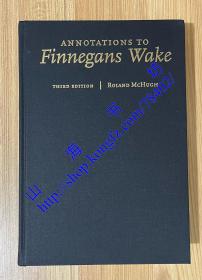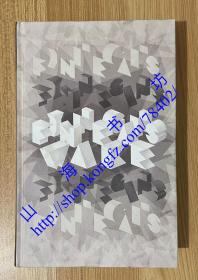
Finnegans Wake(英文原版)
¥ 106 九品
仅1件
作者Joyce;James
出版社Penguin USA
出版时间1999-12
装帧其他
货号021
上书时间2024-11-30
- 最新上架
商品详情
- 品相描述:九品
图书标准信息
- 作者 Joyce;James
- 出版社 Penguin USA
- 出版时间 1999-12
- ISBN 9780141181264
- 装帧 其他
- 开本 其他
- 纸张 其他
- 【内容简介】
- Having done the longest day in literature with his monumental Ulysses, James Joyce set himself even greater challenges for his next book -- the night. "A nocturnal state...That is what I want to convey: what goes on in a dream, during a dream." The
- 【作者简介】
-
Finnegans Wake, published in 1939, is James Joyce's final novel. Following the publication of Ulysses in 1922, Joyce began working on the "Wake" and by 1924 installments of what was then known as Work in Progress began to appear. (The final title of the work remained a secret between the writer and his wife, Nora Barnacle.)
The seventeen years spent working on Finnegans Wake were often difficult for Joyce. He underwent frequent eye surgeries, lost long-time supporters, and dealt with personal problems in the lives of his children. These problems and the perennial financial difficulties of the Joyce family are described in Richard Ellmann's biography James Joyce.
Plot summary
Spoiler warning: Plot and/or ending details follow.
Because Joyce's sentences are packed with obscure allusions and puns in dozens of different languages, it remains impossible to offer an undisputed and definitive synopsis.
The book begins with one such allusion:
riverrun, past Eve and Adam's, from swerve of shore to bend of bay, brings us by a commodius vicus of recirculation back to Howth Castle and Environs.
"Commodious vicus" refers to Giambattista Vico (1668-1744). Vico believed in a theory of cyclical history. He believed that the world was coming to the end of the last of three ages, these being the age of gods, the age of heroes, and the age of humans. This opening also contributes to the effect of Joyce's novel as a whole, since it begins and ends with "riverrun" on the lips.
More generally, the introductory chapter gives an overview of the novel's themes. First, we hear of a central character, here called Finnegan and identified as a hod carrier in Dublin (seen as representing all builders of all kinds throughout world history), falling to his death from a scaffold or tower or wall. At his wake, in keeping with the comic song "Finnegan's Wake" that provided Joyce's title, a fight breaks out, whiskey splashes on Finnegan's corpse, and he rises up again alive (Finnegan awakes).
This Finnegan is all men, and his fall is all men's fall. Subsequent vignettes in the first chapter show him as a warrior (in particular, as Wellington at Waterloo), as an explorer invading a land occupied by his aboriginal ancestors, and as the victim of a vengeful pirate queen (Grace O'Malley).
At the end of chapter one, Joyce puts Finnegan back down again ("Now be aisy, good Mr Finnimore, sir. And take your laysure like a god on pension and don't be walking abroad"). A new version of Finnegan-Everyman is sailing into Dublin Bay to take over the story: Humphrey Chimpden Earwicker, whose initials HCE ("Here Comes Everybody") lend themselves to phrase after phrase throughout the book (Note they appear as "Howth Castle and Environs" in the opening sentence).
Chapter two opens with an account of how HCE was given the name "Earwicker" by the king, who catches HCE "earwigging" when he's supposed to be manning a tollgate. Although the name begins as an insult, it helps HCE rise to prominence in Dublin society, but then he's brought down by a rumor about a sexual trespass involving two girls in Phoenix Park (close by Chapelizod).
Most of chapters two through four follow the progress of this rumor, starting with HCE's encounter with "a cad with a pipe." The cad asks the time, but HCE misunderstands it as either an accusation or a proposition, and incriminates himself by denying rumors the cad has not yet heard. Joyce expresses HCE's confusion by spelling the cad's Gaelic phonetically, making it look like a suggestive English phrase. Eventually, HCE becomes so paranoid he goes into hiding, where he'll write a book that evidently resembles Joyce's own Ulysses.
HCE is (at one level) a Scandinavian who has taken a native Irish wife, Anna Livia Plurabelle (whose initials ALP are also found in phrase after phrase). At some point these two have settled down to run a public house in Chapelizod, a suburb of Dublin named for the Irish princess Isolde. HCE personifies the city of Dublin (which was founded by Vikings), and ALP personifies the river Liffey, on whose banks the city was built. In the popular eighth chapter, hundreds of names of rivers are woven into the tale of ALP's life. Joyce universalizes his tale by making HCE and ALP stand, as well, for every city-river pair in the world. And they are, like Adam and Eve, the primeval parents of all the Irish and all humanity.
ALP and HCE have a daughter, Issy, whose personality is often split, and two sons, Shem and Shaun, eternal rivals for replacing their father and for Issy's affection (among other things). Shem and Shaun are akin to Set and Horus of the Osiris story, as well as the biblical pairs Jacob & Esau and Cain & Abel, as well as Romulus & Remus and St. Michael & the Devil (Mick & Nick).
Shaun is portrayed as a dull postman, conforming to society's expectations, while Shem is a bright artist and sinister experimenter. (As HCE retreats before the rumors, he seems to transform into Shem, the artist who writes the book.) They are sometimes accompanied by a third personality in whom their twin poles are reconciled, called Tristan or Tristram. Presumably, by synthesizing their strengths Tristan is able to win Issy and defeat/replace HCE, like Tristan in the triangle with Iseult (Issy) and King Mark (HCE).
The book also draws heavily on Irish mythology with HCE sometimes corresponding to Finn MacCool, Issy and ALP to Grania, and Shem/Shaun to Dermot (Diarmaid). This is just a small hint of the many roles that each of the main characters finds him or herself playing, often several at the same time.
The book is transformed into a letter, dictated to Shem by ALP, entrusted to Shaun for delivery, but somehow ending up in a midden heap, where it is dug up by a hen named Biddy (the diminutive form of Brighid, which is the name of both a saint and a goddess on whose feast day Joyce was born). The letter is perhaps an indictment, perhaps an exoneration of HCE, just as Finnegans Wake is a vast "comedy" that seeks to indict and simultaneously redeem human history.
If HCE can also be identified with Charles Stewart Parnell, Shem's attack mirrors the attempt of forger Richard Piggott to incriminate Parnell in the Phoenix Park Murders of 1882 by means of false letters. But Piggott is also HCE, for just as HCE betrays himself to the cad, Piggott betrayed himself at the enquiry into admitting the forgery by his spelling of the word "hesitancy" as "hesitency"; and this misspelling appears frequently in the Wake.
The progress of the book is far from simple as it draws in mythologies, theologies, mysteries, philosophies, histories, sociologies, astrologies, other fictions, alchemy, music, colour, nature, sexuality, human development, and dozens of languages to create the world drama in whose cycles we live.
The book ends with the river Liffey disappearing at dawn into the vast possibilities of the ocean. The last sentence is incomplete. As well as leaving the reader to complete it with his or her own life, it can be closed by the sentence that starts the book – another cycle. Thus, reading the final sentence of the book, and continuing on to the first sentence of the book, we have: "A way a lone a last a loved a long the / riverrun, past Eve and Adam's, from swerve of shore to bend of bay, brings us by a commodius vicus of recirculation back to Howth Castle and Environs."
相关推荐
-

Finnegans Wake
八五品苏州
¥ 100.00
-

Finnegans Wake
八五品惠州
¥ 260.00
-

Finnegans Wake
八五品扬州
¥ 185.00
-

Finnegans Wake
八五品扬州
¥ 236.00
-

Finnegans Wake (Wordsworth Classics)
八五品上海
¥ 82.00
-

Finnegans Wake James Joyce
八五品沈阳
¥ 80.00
-

Finnegans Wake (Wordsworth Classics)
九品芜湖
¥ 80.00
-

Annotations to Finnegans Wake
九品北京
¥ 1299.00
-

The Restored Finnegans Wake
八五品北京
¥ 3599.00
-

Finnegans Wake 英文原版
九品商丘
¥ 126.10
— 没有更多了 —





















以下为对购买帮助不大的评价